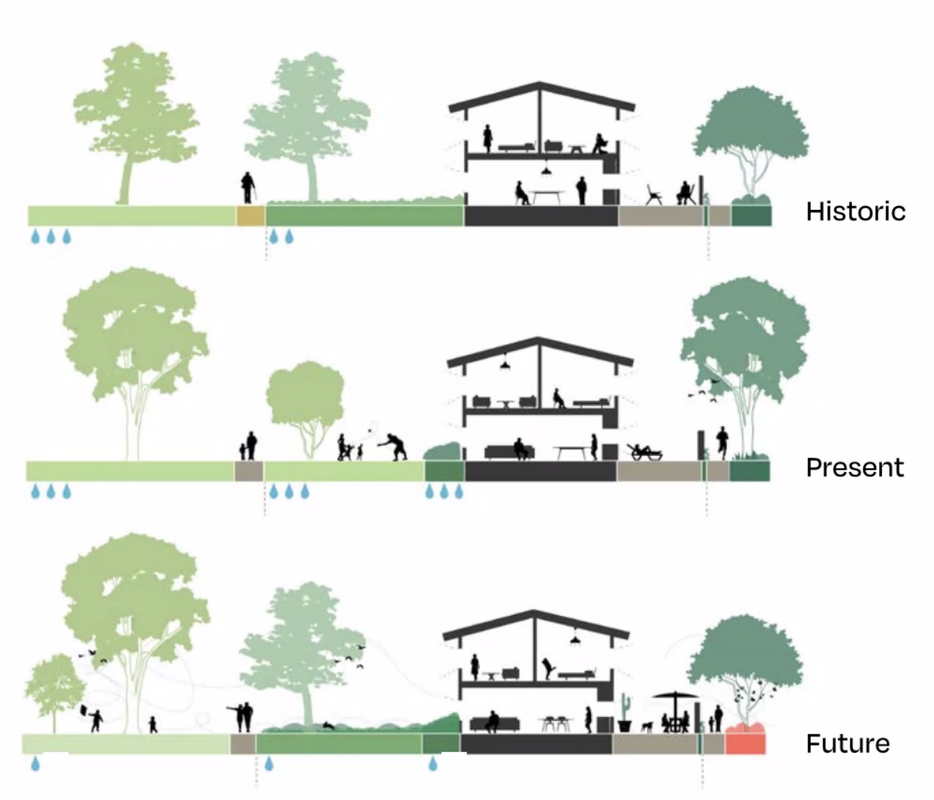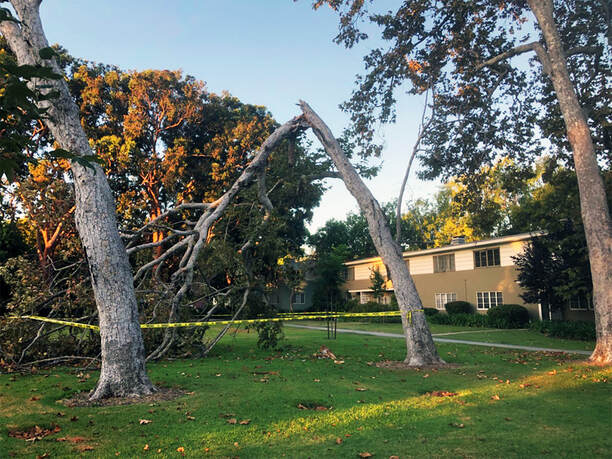Compiled by P.J.C.
| Thirty-six people attended a long, jam-packed Board Meeting on Tuesday, September 27. A number of consequential topics were discussed, including Master Planting Guidelines from RIOS, shot hole borer tree pests, and the 2023 budget outlook. |
update on master planting guidelines
Peter Emerson and Jessa Chisari of landscape architecture firm RIOS gave an update on the Master Planting Guidelines project, describing it as a huge opportunity for “the complete renovation of the existing irrigation system, respecting the historical landscape, improving biodiversity, expanding amenities for residents, and reducing water use significantly.”
They recommended reducing the amount of lawn to cut water use, an objective that aligns with the original 1942 Barlow landscaping plan. “Barlow installed 11 acres of turf; today we have 29,” said Chisari, who is a Village Green resident. “Lawn is the thirstiest thing we can grow.” The RIOS team suggested replacing the lawn in the areas found directly outside units’ front doors with a diverse selection of low maintenance, drought-tolerant, native and adapted plant species, which will have the added benefit of sustaining pollinators and other wildlife. (See graphic above, courtesy of RIOS.)
Existing lawns in common areas that constitute shared space, like the Garden Courts and Main Green, East and West Green parcels, would remain intact.
RIOS also recommended restoring a number of the property’s original amenities by converting some beds at the edges of the Garden and Garage Courts into play areas, seating areas, and specialty plantings.
RIOS urged the hiring of a full-time, experienced landscape director to oversee the project’s planning, execution, and long-term maintenance. “This campus is a dream job for some highly qualified horticulturist,” says Emerson.
After some discussion, the Board asked the Tree & Landscape Committee to work with RIOS to create visual representations of the recommendations for review at a future Board meeting. The Board also agreed to schedule at least one Town Hall Meeting to present the proposed changes to the community, before approving any plan.
They recommended reducing the amount of lawn to cut water use, an objective that aligns with the original 1942 Barlow landscaping plan. “Barlow installed 11 acres of turf; today we have 29,” said Chisari, who is a Village Green resident. “Lawn is the thirstiest thing we can grow.” The RIOS team suggested replacing the lawn in the areas found directly outside units’ front doors with a diverse selection of low maintenance, drought-tolerant, native and adapted plant species, which will have the added benefit of sustaining pollinators and other wildlife. (See graphic above, courtesy of RIOS.)
Existing lawns in common areas that constitute shared space, like the Garden Courts and Main Green, East and West Green parcels, would remain intact.
RIOS also recommended restoring a number of the property’s original amenities by converting some beds at the edges of the Garden and Garage Courts into play areas, seating areas, and specialty plantings.
RIOS urged the hiring of a full-time, experienced landscape director to oversee the project’s planning, execution, and long-term maintenance. “This campus is a dream job for some highly qualified horticulturist,” says Emerson.
After some discussion, the Board asked the Tree & Landscape Committee to work with RIOS to create visual representations of the recommendations for review at a future Board meeting. The Board also agreed to schedule at least one Town Hall Meeting to present the proposed changes to the community, before approving any plan.
fighting tree pests
Arborist Cy Carlberg and Jeanne Jones of pest management company RPW were invited to address a threat to our urban forest: an invasive, non-native beetle that is destroying trees all over Southern California.
The shot hole borer beetle is ravaging the Village’s tree population, in particular mature sycamore trees: a June survey revealed that 155 trees were at-risk. The Board unanimously approved a plan to mitigate the scourge through the use of insecticides, fungicides, and nutritional treatments, at a cost of $112,600.
The shot hole borer beetle is ravaging the Village’s tree population, in particular mature sycamore trees: a June survey revealed that 155 trees were at-risk. The Board unanimously approved a plan to mitigate the scourge through the use of insecticides, fungicides, and nutritional treatments, at a cost of $112,600.
budget outlook, 2023
Treasurer Claire Knowlton presented the Board with a draft budget for 2023, a year projected to have more expenses owing to inflation, as well as rising insurance and maintenance costs. In addition, the electrical and irrigation upgrades are projected to cost $2.5M per year. The Board will consider a dues increase of between 5% and 7% to pursue these projects when it votes on the final budget at the October meeting.



 RSS Feed
RSS Feed